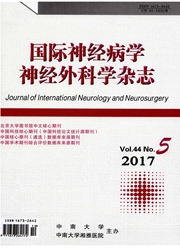

 中文摘要:
中文摘要:
目的研究心肺复苏后缺血缺氧性脑病的临床与影像学表现。方法回顾性分析2002年1月至2011年10月中南大学湘雅医院收治的28例成人心肺复苏后缺血缺氧性脑病患者的临床及影像学资料。结果患者可出现继发性癫痫持续状态、急性症状性肌阵挛、Lance—Adams综合征、脑血管意外等多种临床表现;46.43%(13例/28例)的患者为植物生存状态。CT和MRI影像学检查发现患者早期(发病后1周)多表现为脑回肿胀,并存在弥散性脑损害;同时可合并脑出血,脑梗死,蛛网膜下腔出血等;在疾病晚期(发病后3个月)影像学检查表现为脑萎缩和(或)脑积水。病情越重的患者头部MRI成像异常表现越明显。当MRI显示3个或3个以上不同脑区受累时,GCS评分显示其意识状态显著差于受累部位少或影像学检查正常的患者。结论引起心肺复苏后缺血缺氧性脑病的病因不一,其临床表现和MRI等影像学检查对本病的预后判断可有一定的意义。
 英文摘要:
英文摘要:
Objective To explore the clinical and imaging features of anoxic-ischemic encephalopathy (AIE) patients after cardiopulmonary resuscitation. Methods A total of 28 qualified AIE patients during the last decade from Xiangya Hospital, Central South University were recruited and analyzed retrospectively. Results The symptoms of status epilepticus, acute posthypoxic myoclonus, Lance-Adams syndrome, subarachnoid hemorrhage and cognitive deficits were observed. The abnormal findings of magnetic resonance imaging (MRI) or computed tomography ( CT), involving neocortex, basal ganglia and para- ventricular white matter, were also recorded. During the early phase of disease, swollen cortex was present on MRI/CT. However, encephalatrophy appeared during the late phase. The more severe symptoms were observed, the more foci were present on MRI/CT. Conclusion The etiologies of AIE patients are heterogeneous after cardiopulmonary resuscitation. The clinical symptoms and imaging studies are of prognostic significance.
 同期刊论文项目
同期刊论文项目
 同项目期刊论文
同项目期刊论文
 期刊信息
期刊信息
